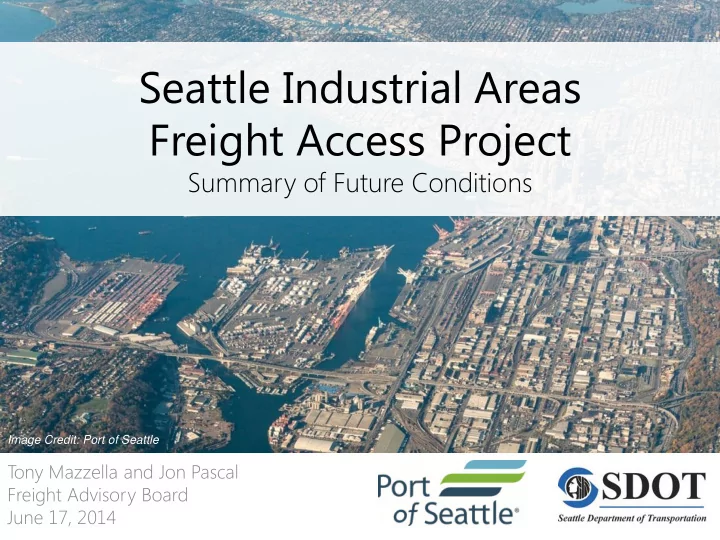

Seattle Industrial Areas Freight Access Project Summary of Future Conditions Image Credit: Port of Seattle T ony Mazzella and Jon Pascal Freight Advisory Board June 17, 2014
Presentation overview • What drives future traffic growth – overview of assumptions • Changes to the transportation network – assumed improvements • Forecast traffic volumes along key corridors • Next steps • Questions 2
Regional growth and truck tonnage
Future travel demands • Population and employment are expected to grow by more than 25% by 2035 • Future travel demand will grow with population and economic activity • Vehicle trips will not grow as significantly due to transit expansion and tolling • Truck activity will grow faster than regional traffic • Street network will remain much the same except for programmed projects and SDOT changes in managing streets for transit, bicycles, and passenger rail
What drives future traffic growth? Vehicle mode Reasons change occurs • Population and employment growth Passenger • Changes in land use and modal options Vehicles Alaskan Way Viaduct T olling Study Sources • PSRC Travel Demand Model • Non-Port • MIC industrial growth Trucks • Changing industry composition Commodity Flow Profile from Freight Source Analysis Framework (FAF3) Port Trucks • Trade growth and intermodal shifts Port of Seattle Container T erminal Source 5 Access Study
Non-port truck trips growth • MICs will comprise an increasing share of regional goods movement dependent industry activity Construction Transportation Natural Resources Utilities Manufacturing Retail Wholesale Food Services • Output and demand from goods movement dependent industries is growing faster than employment – productivity gains • As a result, non-port truck trips will grow faster than overall regional traffic 6
Goods movement dependent industry growth 100% Annual Annual Annual Annual % Share of Total Employment Growth Rate Growth Rate Growth Rate Growth Rate = 1.2% = 1.1% = 1.8% = 1.8% 80% by Geography 60% Retail/Food 40% Man/WTU Const/Res 20% 0% 2010 2035 2010 2035 2010 2035 2010 2035 Ballard-Interbay Duwamish MIC Seattle PSRC Region MIC 7 Source: PSRC Employment Forecasts, 2010.
Non-port truck trips growth by commodity type 60,000 Annual Growth Rate Estimated Daily Non-Port = 2.7% in Seattle CSA Region 50,000 Loaded Truck Trips 40,000 Unknown Food / Agri Prods 30,000 Retail Prods Mfg Prods Const Prods / Res 20,000 10,000 - 2011 2035 Source: Regional Forecasts from FHWA's FAF3 National Model and Cambridge 8 Systematics Assumptions on Average Truck Payload Factors by Commodity.
Port truck trips growth • Consistent with the Port of Seattle Growth Goal of 3.5 million TEUs/Year 9 Source: Port of Seattle Container T erminal Access Study, 2014.
Transportation network changes • Improvements to the transportation system will change routing patterns – New projects – T olling • Shifting routes of auto trips and changes in congestion will impact truck routing ‒ Relative pattern of truck route shifts obtained from PSRC model 10
Assumed improvements LINK Light Rail Mercer er Stree eet Extensi sion on Impr provem vements • Transportation projects SR520 Bridg dge e Repl placem ement ent identified in previous planning studies Viaduct Removal al and Bored ed Tunnel Seattle e • Major projects include: Water erfron ont – Alaskan Way Viaduct Replacement Argo go Yard d North h Access ess Lander er Stree eet – Mercer Street Grade de Separat ation on Improvements – Seattle Waterfront / Alaskan Way South h Park Bridge dge – Lander Street Grade Repl placem ement ent Separation Major Projects 11
Forecasting methodology Passenger Vehicles 2035 Non-Port Forecast Trucks Volumes Port Trucks 12
Truck volumes – reading the maps Average Daily Traffic Average Daily Volume (ADT) Truck Volume Color represents percent of trucks in the traffic stream Example Map
Truck volumes – north PRELI ELIMINA MINARY RY Existing Forecast
Truck volumes – central PRELI ELIMINA MINARY RY Existing Forecast
Truck volumes – south PRELI ELIMINA MINARY RY Existing Forecast
Next steps Future Conditions and Needs July Identification Improvement Project Identification September and Prioritization October / Preparation of Draft Plan November 17
Questions? tony.mazzella@seattle.gov | (206) 684-0811 www.seattle.gov/transportation/freight_industrialareas.htm http://www.seattle.gov/transportation
Recommend
More recommend